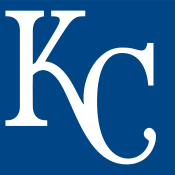Kansas City Royals
The Kansas City Royals are an American professional baseball team based in Kansas City, Missouri. The Royals compete in Major League Baseball (MLB) as a member team of the American League (AL) Central division. The team was founded as an expansion franchise in 1969, and has participated in four World Series, winning in 1985 and 2015, and losing in 1980 and 2014.
| Kansas City Royals | |||||
|---|---|---|---|---|---|
| Established in 1969 | |||||
| |||||
| Major league affiliations | |||||
| |||||
| Current uniform | |||||
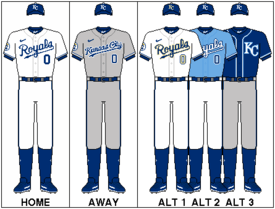 | |||||
| Retired numbers | |||||
| Colors | |||||
| Name | |||||
| |||||
| Other nicknames | |||||
| |||||
| Ballpark | |||||
| |||||
| Major league titles | |||||
| World Series titles (2) | |||||
| AL Pennants (4) | |||||
| Central Division titles (1) | 2015 | ||||
| West Division titles (6) | |||||
| Wild card berths (1) | 2014 | ||||
| Front office | |||||
| Owner(s) | John Sherman | ||||
| Manager | Mike Matheny | ||||
| General Manager | Dayton Moore | ||||
The name "Royals" pays homage to the American Royal, a livestock show, horse show, rodeo, and championship barbeque competition held annually in Kansas City since 1899,[3] as well as the identical names of two former Negro League baseball teams that played in the first half of the 20th century. (One a semi-pro team based in Kansas City in the 1910s and 1920s that toured the Midwest[4] and a California Winter League team based in Los Angeles in the 1940s that was managed by Chet Brewer and included Satchel Paige[5][6] and Jackie Robinson[7] on its roster.)[8] The Los Angeles team had personnel connections to the Monarchs but could not use the Monarchs name. The name also fits into something of a theme for other professional sports franchises in the city, including the Kansas City Chiefs of the NFL, the former Kansas City Kings of the NBA, and the former Kansas City Monarchs of the Negro National League.
In 1968, the team held a name-the-team contest that received more than 17,000 entries. Sanford Porte, a bridge engineer from the suburb of Overland Park, Kansas, was named the winner for his “Royals” entry. His reason had nothing to do with royalty. “Kansas City’s new baseball team should be called the Royals because of Missouri’s billion-dollar livestock income, Kansas City’s position as the nation’s leading stocker and feeder market and the nationally known American Royal parade and pageant,” Porte wrote. The team's board voted 6–1 on the name, with the only opposition coming from team owner Ewing Kauffman, who eventually changed his vote and said the name had grown on him.[9]
Entering the American League in 1969 along with the Seattle Pilots, the club was founded by Kansas City businessman Ewing Kauffman. The franchise was established following the actions of Stuart Symington, then-United States Senator from Missouri, who demanded a new franchise for the city after the Athletics (Kansas City's previous major league team that played from 1955 to 1967) moved to Oakland, California in 1968. Since April 10, 1973, the Royals have played at Kauffman Stadium, formerly known as Royals Stadium.
The new team quickly became a powerhouse, appearing in the playoffs seven times from 1976 to 1985, winning one World Series championship and another AL pennant, led by stars such as Amos Otis, Hal McRae, John Mayberry, George Brett, Frank White, Willie Wilson, and Bret Saberhagen. The team remained competitive throughout the early 1990s, but then had only one winning season from 1995 to 2012. For 28 consecutive seasons (1986–2013), the Royals did not qualify to play in the MLB postseason, one of the longest postseason droughts during baseball's current wild-card era. The team broke this streak in 2014 by securing the franchise's first wild card berth and advancing to the 2014 World Series, where they lost to the San Francisco Giants in seven games. The Royals followed this up by winning the team's first AL Central division title in 2015 and defeating the New York Mets in five games in the 2015 World Series to win their second World Series championship.
Franchise history
1969–1979: Taking Off
The Royals began play in 1969 in Kansas City, Missouri. In their inaugural game, on April 8, 1969, the Royals defeated the Minnesota Twins 4–3 in 12 innings. The Royals went 69–93 in their first season, highlighted by Lou Piniella, who won the AL Rookie of the Year Award.

The team was quickly built through a number of trades engineered by its first General Manager, Cedric Tallis, who picked up center fielder Amos Otis, who became the team's first great star, first baseman John Mayberry, who provided power, second baseman Cookie Rojas, shortstop Fred Patek, designated hitter Hal McRae, and others. The Royals also invested in a strong farm system and soon developed such future stars as pitchers Paul Splittorff, Dennis Leonard, and Steve Busby, infielders George Brett and Frank White, and outfielder Al Cowens. Under these young players, the Royals started to build a young core set up for future success.
In 1971, the Royals had their first winning season, with manager Bob Lemon leading them to a second-place finish. In 1973, under manager Jack McKeon, the Royals adopted their iconic "powder blue" road uniforms and moved from Municipal Stadium to the brand-new Royals Stadium (now known as Kauffman Stadium).
The 1973 All-Star Game was hosted at Royals Stadium, with Otis and Mayberry in the AL starting lineup. The event was previously held at Municipal Stadium in 1960, when the Athletics were based in Kansas City.
Manager Whitey Herzog replaced McKeon in 1975, and the Royals quickly became the dominant franchise in the American League's Western Division. After a second-place, 91 win season, they won three straight division championships from 1976 to 1978, including the franchise's only 100-win season in 1977. However, the Royals lost to the New York Yankees in three straight American League Championship Series encounters.
1980–1984: From Pennant to Pine Tar Incident
After the Royals finished in second place in 1979, Herzog was fired and replaced by Jim Frey. Under Frey and a legendary .390 season from George Brett, the Royals rebounded in 1980 and advanced to the ALCS, where they again faced the Yankees. The Royals vanquished the Yankees in a three-game sweep punctuated by a Brett's home run off of Yankees' star relief pitcher Goose Gossage. After reaching their first World Series, the Royals fell to the Philadelphia Phillies in six games. Game 6 was also significant because it remains the most-watched game in World Series history with a television audience of 54.9 million viewers.[11]
In July 1983, while the Royals were headed for a second-place finish behind the Chicago White Sox another chapter in the team's rivalry with the New York Yankees occurred. In what has come to be known as "the Pine Tar Incident", umpires discovered illegal placement of pine tar (more than 18 inches up the handle) on third baseman George Brett's bat after he had hit a two-run home run off Gossage that put the Royals up 5–4 in the top of the 9th. After Yankee Manager Billy Martin came out of the dugout to talk to home plate umpire Tim McClelland, McClelland and the other umpires mulled over the bat (measuring it over home plate, touching it, etc.). McClelland then pointed to Brett in the dugout and gave the "out" sign, disallowing the home run. Enraged, Brett stormed out of the dugout toward McClelland and Martin, and McClelland ejected Brett. The homer was later reinstated by AL President Lee MacPhail, and the Royals won the game after it was resumed several weeks later.
The 1983 season was also notable for some transitional changes in the Royals organization. First, owner Ewing Kauffman sold 49% of his interest to Memphis developer Avron Fogelman. Second, John Schuerholz was named general manager. Schuerholz soon bolstered the farm system with pitchers Bud Black, Danny Jackson, Mark Gubicza, David Cone, and Bret Saberhagen, as well as hitters such as Kevin Seitzer.
Thanks to the sudden and surprising maturation (specifically, in pitching) of most of the aforementioned players, the Royals won their fifth division championship in 1984, relying on Brett's bat and the young pitching staff of Saberhagen, Gubicza, Charlie Leibrandt, Black and Jackson. The Royals were then swept by the Detroit Tigers in the American League Championship Series. The Tigers went on to win the World Series.
1985: "The I-70 Series"
In the 1985 regular season the Royals topped the Western Division for the sixth time in ten years, led by Bret Saberhagen's Cy Young Award-winning performance and George Brett's self-described best "all around year." Throughout the ensuing playoffs, the Royals came back from 2–0 and 3–1 deficits, but managed to win the Series. In game three, with KC down 2 games to 0, George Brett homered twice and doubled off the fence in right field to put Kansas City back into the series. With the Royals down three-games-to-one in the American League Championship Series against the Toronto Blue Jays, the Royals eventually rallied to win the series 4–3.
1985 World Series
In the 1985 World Series (nicknamed the "I-70 Series" because the two teams are both located in the state of Missouri and connected by Interstate 70) against the cross-state St. Louis Cardinals, the Royals again fell behind, three games to one. After Danny Jackson pitched the Royals to a 6–1 win in game five, the Cardinals and Royals headed back to Kansas City for game six. Facing elimination, the Royals trailed 1–0 in the bottom of the 9th inning, when Jorge Orta led off, hitting a bouncing ground ball to Cardinals 1st basemen Jack Clark, who flipped the ball back to pitcher Todd Worrell at first base. The ball beat Orta to the bag, but umpire Don Denkinger called him safe, and following a dropped popup by Clark and a pass ball the Royals rallied to score two runs, winning on a walk-off single from pinch hitter Dane Iorg to send the series to game seven. In game seven Bret Saberhagen shutout the Cardinals as Kansas City dominated the Cardinals 11–0, clinching their first title in franchise history.[12]
1986–1994: Staying in the Picture
The Royals maintained a reputation as one of the American League West's top teams throughout the late 1980s. The club posted a winning record in three of the four seasons following its 1985 World Series championship, while developing young stars such as Bo Jackson, Tom Gordon, and Kevin Seitzer.[13] The Royals finished the 1989 season with a 92–70 record (third-best in the major leagues) but did not qualify for the playoffs, finishing second in their division behind the eventual World Series champion Oakland Athletics.[13]
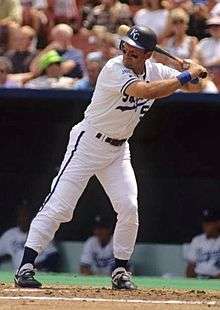
At the end of the 1989 season, the team boasted a powerhouse pitching rotation, including the AL Cy Young Award-winner Bret Saberhagen (who set franchise record 23 wins that year), two-time All-Star Mark Gubicza (a 15-game winner in 1989) and 1989 AL Rookie of the Year runner-up Tom Gordon (who won 17 games that year).[14] But the organization felt it was still missing a few necessary pieces to give its divisional rival Oakland Athletics a run for their money.[15] So prior to the 1990 season, the Royals acquired Mark Davis, the 1989 National League Cy Young Award-winner and league leader in saves, signing him to a 4-year, $13 million contract (the largest annual salary in baseball history at the time).[16] The Royals also signed starting pitcher Storm Davis, who was coming off a career-high 19-game win season (third-best in the AL), to a three-year $6 million contract.[16] Despite the promising off-season moves, the team suffered critical bullpen injuries while both newly signed Davises experienced lackluster seasons in 1990.[15] The Royals concluded the season with a 75–86 record, in second-to-last place in the AL West (and with the worst franchise record since 1970). Bo Jackson—the team's potential future franchise player—suffered a devastating hip injury while playing football in the off-season, so the Royals waived him during spring training in 1991.[17]
Though the team dropped out of contention from 1990 to 1992, the Royals still could generally be counted on to post winning records through the strike-shortened 1994 season. With no playoff appearances despite the winning records during this era, many of the team's highlights instead centered around the end of George Brett's career, such as his third and final batting title in 1990—which made him the first player to win batting titles in three different decades—and his 3,000th hit.
1995–2002: Decline in the Post-Kauffman Era
At the start of the 1990s, the Royals had been hit with a double-whammy when General Manager John Schuerholz departed in 1990 and team owner Ewing Kauffman died in 1993. Shortly before Kauffman's death, he set up an unprecedented complex succession plan to keep the team in Kansas City. The team was donated at his death to the Greater Kansas City Community Foundation and Affiliated Trusts with operating decisions of the team decided by a five-member group chaired by Wal-Mart executive David Glass. According to the plan the Royals had six years to find a local owner for the team before opening ownership to an outside bidder. The new owners would be required to say they would keep the team in Kansas City. Kauffman had feared that new owners would move it noting, "No one would want to buy a baseball team that consistently loses millions of dollars and had little prospect of making money because it was in a small city."[18] If no owner could be found the Kauffman restrictions were to end on January 1, 2002, and the team was to be sold to the highest bidder.[19] In 1999, New York City lawyer and minor league baseball owner Miles Prentice, vowing not to move the team, bid $75 million for the team. This was the minimum amount Kauffman had stipulated the team could be sold for.[20] MLB rejected Prentice's first bid without specifying any reason.[21][22] In a final round of bids on March 13, 2000, the Foundation voted to accept Glass' bid of $96 million, rejecting Prentice's revised bid of $115 million.[23]
During the interregnum under Foundation ownership, the team declined. In 1994 season, the Royals reduced payroll by trading pitcher David Cone and outfielder Brian McRae, then continued their salary dump in the 1995 season. The team payroll, which had previously remained among the league's highest, was sliced in half from $40.5 million in 1994 (fourth-highest in the major leagues) to $18.5 million in 1996 (second-lowest in the major leagues).[24][25]
As attendance slid and the average MLB salary continued to rise, rather than pay higher salaries or lose their players to free agency, the Royals traded their remaining stars such as Kevin Appier, Johnny Damon and Jermaine Dye. By 1999, the team's payroll had fallen again to $16.5 million.[24] Making matters worse, most of the younger players that the Royals received in exchange for these All-Stars proved of little value, setting the stage for an extended downward spiral. Indeed, the Royals set a franchise low with a .398 winning percentage (64–97 record) in 1999, and lost 97 games again in 2001.
In the middle of this era, in 1997, the Royals declined the opportunity to switch to the National League as part of a realignment plan to introduce the Arizona Diamondbacks and Tampa Bay Devil Rays as expansion teams. The Milwaukee Brewers made the switch instead.
In 2002, the Royals set a new team record for futility, losing 100 games for the first time in franchise history. They fired manager Tony Muser, and he was replaced by Tony Peña.
2003: A Winning Season
The 2003 season saw a temporary end to the losing, when manager Tony Peña, in his first full season with the club, guided the team to its first winning record (83–79) since 1994 and finished in third place in the AL Central. He was named the American League Manager of the Year for his efforts and shortstop Ángel Berroa was named AL Rookie of the Year.
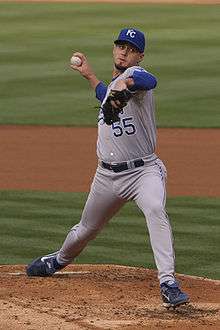
2004–2008: Rock Bottom
From the 2004 season through the 2012 season, the Royals posted nine consecutive losing records, the longest streak in team history. In six of those seasons, the team finished in last place in the American League Central, and in eight of those nine seasons the team lost at least 90 games. The worst seasons came in 2004–2006, when the Royals lost at least 100 games each year and set the franchise's all-time record for losses (56–106 in 2005).
Picked by many to win their division in 2004 after faring well in the free agent market, the Royals got off to a disappointing start and by late June were back in a rebuilding mode, releasing veteran reliever Curtis Leskanic and trading veteran reliever Jason Grimsley and superstar center fielder Carlos Beltrán for prospects, all within a week of each other.
The team subsequently fell apart completely, losing 104 games and breaking the franchise record set just two years earlier. The Royals did, however, see promising seasons from two rookies, center fielder David DeJesus and starting pitcher Zack Greinke. The team continued a youth movement in 2005, but finished with a 56–106 record (.346), a full 43 games out of first place, marking the third time in four seasons that the team reestablished the mark for worst record in franchise history. The season also saw the Royals lose 19 games in a row, a franchise record. During the season manager Tony Peña quit and was replaced by interim manager Bob Schaefer until the Indians' bench coach Buddy Bell was chosen as the next manager. Looking for a quick turnaround, general manager Allard Baird signed several veteran players prior to the 2006 season, including Doug Mientkiewicz, Mark Grudzielanek, Joe Mays and Scott Elarton. Nevertheless, the Royals struggled through another 100-loss season in 2006, becoming just the eleventh team in major league history to lose 100 games in three straight seasons.[26] During the season Baird was fired as GM and replaced by Dayton Moore.
Kansas City entered the 2007 season looking to rebound from four out of five seasons ending with at least 100 losses. The Royals outbid the Cubs and Blue Jays for free agent righty Gil Meche, signing him to five-year, $55 million contract, the largest contract in Royals history. Reliever Octavio Dotel also inked a one-year, $5 million contract. The team also added several new prospects, including Alex Gordon and Billy Butler. Among Dayton Moore's first acts as General Manager was instating a new motto for the team: "True. Blue. Tradition."[27] In June 2007, the Royals had their first winning month since July 2003 and followed it up with a winning July. The Royals finished the season 69–93, but 2007 marked the club's first season with fewer than 100 losses since 2003. Manager Buddy Bell resigned following the 2007 season.[28]
The Royals hired Trey Hillman, formerly the manager of the Nippon Ham Fighters and a minor league manager with the New York Yankees, to be the 15th manager in franchise history.[29] The 2008 season began with the release of fan favorite Mike Sweeney and the trade of Ángel Berroa to the Dodgers. Through 13 games in 2008, the Royals were 8–5 and in first place in the AL Central, a vast improvement over their start from the previous season. However, by the All-Star break, the Royals were again in losing territory, with their record buoyed only by a 13–5 record in interleague play, the best in the American League. The team finished the season in fourth place with a 75–87 record.
2009–2012: Kauffman Renovations and Further Rebuilding

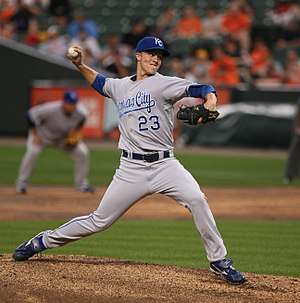
Prior to the 2009 season, the Royals renovated Kauffman Stadium. After the season began, the Royals ended April at the top of the AL Central, all of which raised excitement levels among fans. However, the team faded as the season progressed and finished the year with a final record of 65–97, in a fourth place tie in its division. The season was highlighted by starter Zack Greinke, who did not allow an earned run in the first 24 innings of the season, went on to finish the year with a Major League-leading 2.16 earned run average, and won the American League Cy Young Award. Greinke joined Bret Saberhagen (in 1985 and 1989) and David Cone (in 1994) as the only three players in Royals history to receive the award.
The Royals began the 2010 season with a rocky start, and after the team's record fell to 12–23, manager Trey Hillman was fired. Former Milwaukee Brewers skipper Ned Yost took over as manager. At the end of the 2010 season, the Royals finished with a 67–95 record, in last place in the division for the sixth time in seven years. The Royals also set a dubious franchise record during the season, allowing 42 runs in a three-day span from July 25 to 27. The Royals began 2011 with a hot start with a 10–4 record after 14 games, but success faded as the season progressed. The Royals last had a .500 record at 22–22, and by the All-Star break, the Royals had a record of 37–54, the worst in the American League. Almost all of the Royals' bullpen was called up in 2011 and the call up of the infielders Eric Hosmer, Mike Moustakas, Manny Piña, Johnny Giavotella, and Salvador Pérez. Hosmer won the AL Rookie of the Month award in July and September and finished the season with 19 home runs. Moustakas collected a fifteen-game hitting streak, which tied the largest such streak by a Royal rookie. The Royals finished the 2011 season with a 71–91 record. The 2012 team saw more of the same, as they improved by one game to 72–90.
The 2012 Major League Baseball All-Star Game was hosted by the Royals at Kauffman Stadium on July 10, 2012 (in addition to the 2012 Home Run Derby, All-Star Futures Game and Taco Bell All-Star Legends and Celebrity Softball Game during the All-Star break), which the National League won 8–0. The 2012 season marked the third time the "Midsummer Classic" was held in Kansas City.
2013: Return to Respectability
On December 10, 2012, in an attempt to strengthen the pitching staff (which was among the worst in baseball in 2012), the Royals traded for Rays pitchers James Shields and Wade Davis giving Tampa top prospects Wil Myers, Jake Odorizzi, Mike Montgomery, and Patrick Leonard. This trade helped catalyze a return to winning records.
In the 2013 season, the Royals remained over .500 nearly most of April during regular season play. The team also did not commit an error in its first seven games (for 64 2⁄3 innings) for the first time in team history. On September 22, the Royals won their 82nd game of the season to clinch the franchise's first winning season since 2003. The Royals finished the season 86–76, securing the team's best winning percentage since 1994.
2014: Return to the World Series
The 2014 season was even more successful, featuring a return to the postseason for the first time in 29 years, and what would unfold as a historic playoff run to the 2014 World Series.
Anchored by the HDH Line (Bullpen trio of Kelvin Herrera, Wade Davis, and Greg Holland), the bullpen became one of the most dominant in MLB history.
Entering the 2014 season, the Royals had the longest playoff drought of any team in the four main American professional sports leagues (NFL, MLB, NHL, and NBA). On July 21, 2014, the Royals had a losing record (48–50) and were eight games behind the Detroit Tigers in the AL Central standings. But spurred by a 22–5 record from July 22 to August 19 coinciding with a mediocre 12–15 stretch by the Tigers, the team surged into first place in the AL Central. The Royals reached the top of the division standings on August 11, after winning their eighth game in a row.[30] This marked the latest date the Royals had led their division since August 29, 2003.[30] The team retained its division lead for a month, before falling out of first-place permanently on September 12. They finished the 2014 regular season with a record 89–73, still the most wins for the Royals since 1989. Though the team finished one game behind Detroit in the AL Central, the Royals secured their first-ever wild card berth.
After qualifying for the postseason, the Royals embarked on a record-setting eight-game winning streak. They hosted the Oakland Athletics in the 2014 American League Wild Card Game and won 9–8 on a Salvador Pérez walk-off single in the 12th inning, having earlier rallied back from a 7–3 deficit in the eighth. The Royals then swept the Los Angeles Angels of Anaheim in the 2014 American League Division Series. In Game 1 of the ALDS, the score was 2–2 going into the 11th inning, when Mike Moustakas hit a game-winning solo home run. The next day, Kansas City beat the Angels 4–1 in another extra-innings affair, in the process setting an MLB postseason record of three straight extra-inning wins.[31] The Royals then completed the sweep at home, winning 8–3 in game three and advancing to the 2014 American League Championship Series against the Baltimore Orioles.[32]
In the opening game of the ALCS on October 11, 2014, the Royals defeated the Orioles 8–6, with two home runs in the 10th inning. Thus, in eight extra innings over five postseason games in 2014, they succeeded in hitting four homers in extra innings, more than any team in the history of Major League Baseball.[33] In the second ALCS game, the Royals again beat the Orioles 6–4, behind Lorenzo Cain's four hits, including an RBI single.[34] After game three, the ALCS was delayed one day due to rainy weather, when the Royals hosted the Orioles at Kauffman Stadium on October 14, 2014. Pitcher Jeremy Guthrie allowed only one run as KC beat the Orioles 2–1, taking a 3–0 lead in the series. In game four, the Royals completed the sweep of the Orioles with another 2–1 win to advance to the World Series for the first time since 1985. The win marked the team's eighth consecutive postseason win in one year, breaking a major league record previously held by the Colorado Rockies in 2007 and Cincinnati Reds in 1976. It also marked the Royals' 11th win in a row overall in postseason play, dating back to the franchise's final three wins of the 1985 Series, the third-longest multi-year postseason streak in baseball history.[35]
The Royals faced the San Francisco Giants in the 2014 World Series. They had home-field advantage, due to the American League's win in the 2014 All-Star Game.
After setting an AL record by winning eight straight games to reach the World Series, the Royals opened the series by losing 7–1 in the first game against starter Madison Bumgarner. The Royals bounced back with a 7–2 win in game two to tie the series at 1–1. The Royals won game three in San Francisco 3–2 to take the series lead for the first time. In game four, the Royals lost 11–4, which tied the series with the Giants. In game five, they lost 5–0 to the Giants against starter Madison Bumgarner. In game six, the Royals beat the Giants 10–0. In game seven, the Royals started RHP Jeremy Guthrie against Giants pitcher Tim Hudson. Guthrie lasted 3 1⁄3 innings before he was replaced by Kelvin Herrera, who himself lasted 2 2⁄3 innings. He was then replaced by Wade Davis, who pitched in two innings. Closer Greg Holland ended the game. On the Giants side, Hudson lasted only 1 2⁄3 innings before he was replaced by Jeremy Affeldt, who was later replaced by Madison Bumgarner. The Royals lost game seven, 3–2, with the tying run (Alex Gordon) on third base in the bottom of the ninth with two outs, when Salvador Pérez fouled out to Pablo Sandoval to end the game and the series.
2015: World Series Champions
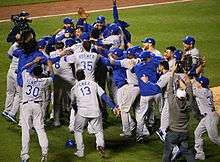
After earning a wild-card entry to the playoffs in 2014, in 2015 the Royals won the franchise's first division title since 1985 and first Central division title ever (the Central was created in 1994). The Royals went on to win the 2015 World Series – the first championship for the Royals since 1985 – beating the New York Mets four games to one.[36]
The Royals entered the 2015 All-Star break with the best record in the American League (52–34). The team continued its momentum into the second half of the season, and on July 26, Royals management traded three prospects Brandon Finnegan, John Lamb, and Cody Reed for 2014 All-Star pitcher Johnny Cueto to help bolster its starting pitching rotation, as well as trading for super-utility player Ben Zobrist.[37] The team ended the regular season with a record of 95–67, best in the American League, and the organization's best since 1980.
The Royals faced the Houston Astros in the ALDS. Down 2–1 in the series and trailing 6–2 in the 8th inning of Game 4, the Royals rallied for 5 runs en route to a 9–6 win before Cueto's gem in Game 5 powered the Royals to a second consecutive ALCS.[38] The Royals defeated the Toronto Blue Jays in Game 6, to win the 2015 ALCS and earn a trip to face the New York Mets in the 2015 World Series.
The Royals beat the New York Mets 4 games to 1 to become the 2015 World Series champions.[36] It was the Royals' first World Series title since 1985. The series win was sealed after the Royals beat the Mets 7–2 in the 12th inning of Game 5. The Royals rallied in the 9th inning down 2–0 to tie the score 2–2, forcing the game into extra innings. The five-run 12th inning was initiated by a Perez single and Dyson pinch-running for him. This was followed by a single from Christian Colon, doubles from both Alcides Escobar and Lorenzo Cain, scoring runs from Jarrod Dyson, Colon, Paulo Orlando (who reached base on an error by Daniel Murphy), Escobar and Ben Zobrist (who was intentionally walked). Wade Davis, who hadn't allowed a run yet that postseason, closed out the game with a flawless 12th, allowing a hit and striking out Wilmer Flores to end the game and win the World Series for the Royals.[39]
2016–2017: End of an Era
The Royals followed up their World Series victory with an underachieving, injury-riddled campaign in 2016. The Royals had an inconsistent season in which they fittingly finished 81–81, third place in the division and out of the playoffs. This season is notable for the debut of future star Whit Merrifield. The 2017 season marked the end of the past World Series core. Pitcher Yordano Ventura was killed in a car crash on January 22, and the Royals wore patches that said 'ACE 30' on their jerseys for the 2017 season to honor Ventura. Wade Davis was traded in the off season, and after a second consecutive non-playoff season, finishing 80–82, stars Lorenzo Cain and Eric Hosmer left the team in free agency.
2018–present: Another Rebuild and Selling of the Team
Although Hosmer and Cain left in free agency, the Royals were still able to re-sign Mike Moustakas and Alcides Escobar. In 2018, the team started a new rebuild, trading Moustakas mid-season for prospects, and giving playing time to young players like Adalberto Mondesi, Ryan O'Hearn, and Brad Keller. Despite this, the team finished with a 58-win season, the team's fewest wins total since 2005. The season also marked the emergence of Merrifield as a star, as he led the Major Leagues in hits (192) and stolen bases (45).
On August 30, 2019 it was announced that John Sherman, a minority owner of the Cleveland Indians, had agreed to purchase the team from David Glass for a reported amount of $1 billion. The Royals finished the 2019 season one game better at 59-103 and manager Yost announced that he would retire at the end of the season after ten seasons and a franchise record 746 wins.[40] Merrifield once again led the league in hits, while Jorge Soler led the American League with 48 home runs and three players paced the league in triples (Mondesi, Merrifield and Hunter Dozier, with 10 apiece).
Rivalries
St. Louis Cardinals
The Royals' most prominent rivalry is with the intrastate St. Louis Cardinals. For geographic reasons, the teams long played exhibition games, but a true rivalry began with the Royals' victory over the Cardinals in the 1985 World Series, known as the "I-70 Series." Notably, the manager for the Cardinals in the series was Whitey Herzog, who had been the Royals' manager from 1975 to 1979, and led Kansas City to the franchise's first three playoff appearances – in 1976, 1977, and 1978 – before getting fired just shortly after the Royals were eliminated from the playoffs in 1979. Interleague play in 1997 allowed the I-70 Series to be revived in non-exhibition games. The first few seasons of the series were rather even, with the Cardinals holding a slight advantage with a 14–13 record through the 2003 season. Through the 2016 season, the Cardinals hold the series advantage 51–39.
Historic rivalry
From 1976 to 1980, the Royals faced the New York Yankees four times in five years in the American League Championship Series. The Yankees won in 1976, 1977 and 1978, while the Royals won in 1980. In a 2013 article about the 1983 Pine Tar Incident involving the two teams, Lou Pinella said: "As a team, we didn't really like Kansas City. We had played them in the '76, '77 and '78 postseason and beaten them every time. There was no love lost between the teams. We didn't like each other. They were our big rivals..."[41] George Brett agreed: "I hated everyone on the Yankees, I really did. I hated 'em all, back in that era."[41]
Baseball Hall of Famers
| Kansas City Royals Hall of Famers | |||||||||
|---|---|---|---|---|---|---|---|---|---|
| Affiliation according to the National Baseball Hall of Fame and Museum | |||||||||
|
Ford C. Frick Award recipients
| Kansas City Royals Ford C. Frick Award recipients | |||||||||
|---|---|---|---|---|---|---|---|---|---|
| Affiliation according to the National Baseball Hall of Fame and Museum | |||||||||
|
Other players of note
Team captains
- 5 George Brett 1989–1993
- 20 Frank White 1989–1990
- 29 Mike Sweeney 2003–2007
Missouri Sports Hall of Fame
| Kansas City Royals in the Missouri Sports Hall of Fame | ||||
| No. | Player | Position | Tenure | Notes |
|---|---|---|---|---|
| – | Ewing Kauffman | Founder/Owner | 1969–1993 | Born near Garden City, grew up in Kansas City |
| – | Art Stewart | Scout | 1969–present | |
| – | George Toma | Groundskeeper | 1969–1999 | |
| 2, 37 | Fred Patek | SS | 1971–1979 | |
| 5, 25 | George Brett | 3B/DH/1B | 1973–1993 | |
| 6, 19, 32 | Willie Wilson | CF/LF | 1976–1990 | |
| 8, 22 | Jim Eisenreich | OF | 1987–1992 | |
| 7 | John Mayberry | 1B | 1972–1977 | |
| 8, 15, 28 | Mike MacFarlane | C | 1987–1994 1996–1998 | |
| 11 | Hal McRae | OF/DH/Coach Manager | 1973–1987 1991–1994 | |
| 12 | John Wathan | C Manager | 1976–1985 1987–1991 | |
| 15 | Darrell Porter | C | 1977–1980 | Born in Joplin |
| 16 | Bo Jackson | OF/DH | 1987–1990 | |
| 9, 10, 18 | Jamie Quirk | C | 1975–1976 1978–1982 1985–1988 | |
| 19, 20 | Frank White | 2B | 1973–1990 | Attended Longview Community College in Lee's Summit |
| 21 | Jeff Montgomery | RP | 1988–1999 | |
| 22 | Dennis Leonard | SP | 1974–1986 | |
| 23 | Mark Gubicza | SP | 1984–1996 | |
| 24 | Whitey Herzog | Manager | 1975–1979 | Elected mainly on his performance with St. Louis Cardinals |
| 26 | Amos Otis | CF | 1970–1983 | |
| 29, 40 | Vince Coleman | LF | 1994–1995 | |
| 29 | Dan Quisenberry | RP | 1979–1988 | |
| 29 | Mike Sweeney | C/1B/DH | 1995–2007 | |
| 30 | Orlando Cepeda | 1B | 1974 | Elected mainly on his performance with San Francisco Giants |
| 25, 34 | Paul Splittorff | SP | 1970–1984 | |
| 36 | Gaylord Perry | SP | 1983 | Elected mainly on his performance with San Francisco Giants |
| 37 | Jeff Suppan | P | 1998–2002 | |
| 39 | Al Hrabosky | RP | 1978–1979 | |
| 40 | Steve Busby | SP | 1972–1980 | |
Retired numbers
|
The Royals have retired the numbers of former players George Brett (No. 5) and Frank White (No. 20). Former manager Dick Howser's No. 10 was retired following his death in 1987. Former Brooklyn Dodgers player Jackie Robinson's No. 42 is retired throughout Major League Baseball.
Out of circulation, but not retired
No. 29, worn by Royals greats Dan Quisenberry (238 saves, 2.55 ERA) and Mike Sweeney (.299 batting average, 197 home runs, 837 RBI), has not been assigned since Sweeney's departure in 2007. Additionally, the team has not issued No. 30, worn by pitcher Yordano Ventura, since his death in 2017.
Hall of Fame
| Year | Year inducted |
|---|---|
| Bold | Member of the National Baseball Hall of Fame |
| Member of the Baseball Hall of Fame as a member of the Royals | |
| Bold | Recipient of the Hall of Fame's Ford C. Frick Award |
| Kansas City Royals Hall of Fame | ||||
| Inducted | No. | Player | Position | Tenure |
|---|---|---|---|---|
| 1986 | 40 | Steve Busby | SP | 1972–1980 |
| 26 | Amos Otis | CF | 1970–1983 | |
| 1987 | 10 | Dick Howser | Manager | 1981–1986 |
| 1 | Cookie Rojas | 2B | 1970–1977 | |
| 25, 34 | Paul Splittorff | SP | 1970–1984 | |
| 1989 | 22 | Dennis Leonard | SP | 1974–1986 |
| 11 | Hal McRae | OF/DH/Coach Manager | 1973–1987 1991–1994 | |
| 1992 | — | Joe Burke | GM President | 1974–1981 1981–1992 |
| 32, 37 | Larry Gura | SP | 1976–1985 | |
| 2, 37 | Freddie Patek | SS | 1971–1979 | |
| 1993 | — | Ewing Kauffman | Owner and tributary of name of Kauffman Stadium | 1969–1993 |
| 1994 | 5, 25 | George Brett | 3B/DH/1B | 1973–1993 |
| 1995 | 19, 20 | Frank White | 2B | 1973–1990 |
| 1996 | — | Muriel Kauffman | Executive and wife of Ewing | 1969–1995 |
| 7 | John Mayberry | 1B | 1972–1977 | |
| 1998 | 29 | Dan Quisenberry | RP | 1979–1988 |
| 2000 | 24 | Whitey Herzog | Manager | 1975–1979 |
| 6, 19, 32 | Willie Wilson | CF/LF | 1976–1990 | |
| 2003 | 21 | Jeff Montgomery | RP | 1988–1999 |
| 2004 | — | Denny Matthews | Radio announcer | 1969–present |
| 2005 | 18, 31 | Bret Saberhagen | SP | 1984–1991 |
| 2006 | 23 | Mark Gubicza | SP | 1984–1996 |
| 2008 | — | Art Stewart | Scout | 1969–present |
| 2011 | 17, 55 | Kevin Appier | SP | 1989–1999 2003–2004 |
| 2012 | — | George Toma | Groundskeeper | 1969–1999 |
| 2015 | 29 | Mike Sweeney | C/1B/DH | 1995–2007 |
Roster

Kansas City Royals 2020 spring training roster | ||||||
|---|---|---|---|---|---|---|
| 40-man roster | Non-roster invitees | Coaches/Other | ||||
|
Pitchers
|
Catchers
Infielders
Outfielders
Designated hitters
|
Pitchers
Catchers
Infielders
Outfielders
|
Manager
Coaches
31 active, 0 inactive, 17 non-roster invitees
| |||
Managers
Statistics current through December 1, 2018
| #[a] | Manager | Seasons | Wins | Losses | Pct | PA | PW | PL | WS |
|---|---|---|---|---|---|---|---|---|---|
| 1 | Joe Gordon† | 1969 | 69 | 93 | .426 | — | — | — | — |
| 2 | Charlie Metro | 1970 | 19 | 33 | .365 | — | — | — | — |
| 3 | Bob Lemon† | 1970–1972 | 207 | 218 | .487 | — | — | — | — |
| 4 | Jack McKeon | 1973–1975 | 215 | 205 | .512 | — | — | — | — |
| 5 | Whitey Herzog† | 1975–1979 | 410 | 304 | .574 | 3 | 5 | 9 | 0 |
| 6 | Jim Frey | 1980–1981 | 127 | 105 | .547 | 1 | 5 | 4 | 0 |
| 7 | Dick Howser | 1981–1986 | 404 | 365 | .525 | 3 | 8 | 12 | 1 |
| 8 | Mike Ferraro | 1986 | 36 | 38 | .486 | — | — | — | — |
| 9 | Billy Gardner | 1987 | 62 | 64 | .492 | — | — | — | — |
| 10 | John Wathan | 1987–1991 | 287 | 270 | .515 | — | — | — | — |
| 11 | Bob Schaefer | 1991 | 1 | 0 | 1.000 | — | — | — | — |
| 12 | Hal McRae | 1991–1994 | 286 | 277 | .508 | — | — | — | — |
| 13 | Bob Boone | 1995–1997 | 181 | 206 | .468 | — | — | — | — |
| 14 | Tony Muser | 1997–2002 | 317 | 431 | .424 | — | — | — | — |
| 15 | John Mizerock | 2002 | 5 | 8 | .385 | — | — | — | — |
| 16 | Tony Peña | 2002–2005 | 198 | 285 | .410 | — | — | — | — |
| — | Bob Schaefer | 2005 | 5 | 12 | .294 | — | — | — | — |
| 17 | Buddy Bell | 2005–2007 | 174 | 262 | .399 | — | — | — | — |
| 18 | Trey Hillman | 2008–2010 | 152 | 207 | .423 | — | — | — | — |
| 19 | Ned Yost | 2010–2019 | 687 | 736 | .483 | 2 | 22 | 9 | 1 |
| 20 | Mike Matheny | 2020– | 0 | 0 | .000 | 0 | 0 | 0 | 0 |
| Totals | 3842 | 4119 | .483 | 9 | 40 | 34 | 2 | ||
Minor league affiliations
The Kansas City Royals farm system consists of nine minor league affiliates.[42]
| Level | Team | League | Location |
|---|---|---|---|
| Triple-A | Omaha Storm Chasers | Pacific Coast League | Papillion, Nebraska |
| Double-A | Northwest Arkansas Naturals | Texas League | Springdale, Arkansas |
| Class A-Advanced | Wilmington Blue Rocks | Carolina League | Wilmington, Delaware |
| Class A | Lexington Legends | South Atlantic League | Lexington. Kentucky |
| Rookie | Idaho Falls Chukars | Pioneer League | Idaho Falls, Idaho |
| Burlington Royals | Appalachian League | Burlington, North Carolina | |
| AZL Royals | Arizona Summer League | Surprise, Arizona | |
| DSL Royals 1 & 2 | Dominican Summer League | Boca Chica, Santo Domingo |
Season records
- Highest batting average: .390, George Brett (1980)
- Most games: 162, Al Cowens (1977), Hal McRae (1977), Carlos Beltrán (2002), Billy Butler (2013), Alcides Escobar (2014, 2016), Whit Merrifield (2019), Jorge Soler (2019)
- Most runs: 136, Johnny Damon (2000)
- Most hits: 230, Willie Wilson (1980)
- Highest slugging %: .664, George Brett (1980)
- Most doubles: 54, Hal McRae (1977)
- Most triples: 21, Willie Wilson (1985)
- Most home runs: 48, Jorge Soler (2019)
- Most grand slams: 3, Danny Tartabull (1988)
- Most RBIs: 144, Mike Sweeney (2000)
- Most stolen bases: 83, Willie Wilson (1979)
- Most wins: 23, Bret Saberhagen (1989)
- Lowest ERA: 2.08, Roger Nelson (1972)
- Strikeouts: 244, Dennis Leonard (1977)
- Most strikeouts, single game: 16, Danny Duffy (2016)
- Most strikeouts, Reliever: 109, Wade Davis (2014)
- Complete games: 21, Dennis Leonard (1977)
- Shutouts: 6, Roger Nelson (1972)
- Saves: 47, Greg Holland (2013)
All-Time records
- Highest batting average: .306, Jose Offerman
- Most games: 2,707, George Brett
- Most runs: 1,583, George Brett
- Most hits: 3,154, George Brett
- Highest Slugging %: .518, Danny Tartabull
- Most doubles: 665, George Brett
- Most triples: 137, George Brett
- Most home runs: 317, George Brett
- Most RBIs: 1,596, George Brett
- Most stolen bases: 612, Willie Wilson
- Most wins: 166, Paul Splittorff
- Lowest ERA: 2.55, Dan Quisenberry
- Strikeouts: 1,458, Kevin Appier
- Complete games: 103, Dennis Leonard
- Shutouts: 23, Dennis Leonard
- Saves: 304, Jeff Montgomery
Radio and television
As of 2012, the Royals affiliate radio station is KCSP 610AM, the station having entered into a new four-year deal starting from the 2015 season.[43] The radio announcers are Denny Matthews and Ryan Lefebvre, with Steve Stewart and Steve Physioc.[44]
Televised games are aired on Fox Sports Kansas City, a branch of Fox Sports Midwest. For the 2012 season, Ryan Lefebvre will be joined by Jeff Montgomery for about 20 games while the rest of the broadcasts will be covered by former Angels announcer duo of Rex Hudler and Steve Physioc.[45][46] During the 2016 season, the Royals averaged an 11.7 rating and 105,000 viewers on primetime TV broadcasts.[47]
On February 22, 2007, Matthews was selected as the 2007 recipient of the Ford C. Frick Award, presented annually for major contributions to baseball broadcasting.[48]
Mascot
Sluggerrr is the mascot of the Royals. Sluggerrr is a lion, and made his first appearance on April 5, 1996.[49] On game day, Sluggerrr can be found giving aggressive encouragement to players and fans, pitching in the "Little K", and firing hot dogs from an air cannon into the stands between innings.
See also
References
- Kaegel, Dick (November 25, 2013). "New Royals uniforms enhance 'KC' logo". MLB.com. MLB Advanced Media. Retrieved January 26, 2018.
For the first time in franchise history, the familiar "KC" seen on the team's cap is moving to a regular-season uniform jersey. But just for certain games away from home. It will appear in white on the Royals' alternate road royal blue jerseys, unveiled on Monday. The jersey is also trimmed in white with powder blue piping, with the numeral and player name in white with a powder blue outline.
- "Royals 50th Season Book". Royals.com. MLB Advanced Media. Retrieved May 31, 2020.
The ultimate keepsake and the perfect gift for true blue and gold Royals fans of all ages, this official, distinctive showpiece will be a treasure for years to come.
- "Kansas City Royals (1969 – present)" Archived September 18, 2016, at the Wayback Machine, sportsecyclopedia.com
- "Kansas City Royals 1924". Newspapers.com. June 7, 1924. Retrieved November 4, 2018.
- "Kansas City Royals 1947". Newspapers.com. October 20, 1947. Retrieved November 4, 2018.
- http://www.cnlbr.org/Portals/0/Hero/Chet-Brewer.pdf
- Nelson, Curt. "Jackie Robinson: Kansas City Royal? | Kansas City Royals". Mlb.com. Retrieved November 4, 2018.
- "7 Jun 1924, Page 5 – The Chillicothe Constitution-Tribune at". Newspapers.com. June 7, 1924. Retrieved November 4, 2018.
- "The Kansas City Royals are named for cows, not kings and queens". October 17, 2014.
- "Royals to create new uniform tradition with powder blue alternates for 2008". Kansas City Royals. MLB Advanced Media, LP. December 5, 2007. Archived from the original on October 31, 2014. Retrieved October 28, 2014.
- Sandomir, Richard (October 18, 2014). "Baseball World Series: Postseason Vanishing From Broadcast Networks". The New York Times. CLXIV (56, 657): D4. Archived from the original on October 27, 2014. Retrieved October 25, 2014.
- "1985 World Series Kansas City Royals over St Louis Cardinals". Archived from the original on November 30, 2007. Retrieved June 30, 2017.
- "Kansas City Royals Team History & Encyclopedia – Baseball-Reference.com". Archived from the original on April 23, 2012. Retrieved April 16, 2012.
- Horst, Craig (March 25, 1990). "Royals' lineup for 1990 is virtually set". The Daily Union. p. 15. Retrieved April 18, 2012.
- Engel, Michael (December 17, 2011). "The Cautionary Tale of the 1990 Royals". Kings of Kauffman. FanSided. Archived from the original on January 13, 2012. Retrieved April 17, 2012.
- Nightengale, Bob (December 12, 1989). "Royals Sign Mark Davis to $13-Million Contract". Los Angeles Times. p. C1. Archived from the original on April 12, 2013. Retrieved April 16, 2012.
- Horst, Craig (March 19, 1991). "Bo no go, waive star". Kentucky New Era. Associated Press. p. 2B. Retrieved October 3, 2012.
- Published. "New Royals Owner: Greater Kansas City Community Foundation – SportsBusiness Daily, SportsBusiness Journal". SportsBusiness Daily. Retrieved May 18, 2011.
- "Baseball rejects Prentice's bid for Royals". CNN. November 11, 1999. Archived from the original on June 29, 2011.
- "Royals board approves team sale to Prentice group". Archived from the original on November 6, 2012.
- "Microsoft Word – newsltr.002" (PDF). Archived (PDF) from the original on February 5, 2011. Retrieved May 18, 2011.
- "Baseball strikes out Prentice; Royals must again start hunt for bidders", Kansas City Star, November 11, 1999
- "Lengthy sale process could prove beneficial", Kansas City Star, March 15, 2000, Jason Whitlock author
- Dutton, Bob (April 4, 2010). "Royals to Open 2010 Season With $70.1 million Payroll". Kansas City Star. Archived from the original on April 9, 2010. Retrieved April 5, 2010.
- "USA Today Salaries Database". USA Today. October 24, 2007. Archived from the original on November 10, 2009. Retrieved April 5, 2010.
- "KC Breaking News, Sports, Weather & More – KansasCity.com & The Kansas City Star".
- Flanagan, Jeffrey. Royals reach to past with newest slogan Kansas City Star, February 28, 2007.
- Dick Kaegel (May 31, 2005). "Bell stepping down as Royals skipper". KansasCity.Royals.MLB.com. Archived from the original on May 19, 2011. Retrieved May 18, 2011.
- Dick Kaegel. "Royals introduce Hillman as new manager, MLB.com, 22 October 2007". Kansascity.royals.mlb.com. Archived from the original on May 19, 2011. Retrieved May 18, 2011.
- McCullough, Andy (August 11, 2014). "Royals reclaim first place in Central with 3–2 victory over Oakland". Kansas City Star. Archived from the original on August 14, 2014. Retrieved August 18, 2014.
- McCullough, Andy (September 30, 2014). "Royals win AL Wild Card Game in walk-off thriller, 9–8". Kansas City Star. Archived from the original on October 1, 2014. Retrieved September 30, 2014.
- McCullough, Andy. "Royals to play for American League pennant after sweeping Angels with 8–3 win". Kansas City Star. Archived from the original on October 6, 2014. Retrieved October 6, 2014.
- Bertha, Mike. "The small-ball Royals have more extra-inning, postseason home runs than any team ever". MLB.com Cut4. MLB.com. Retrieved October 11, 2014.
- McCullough, Andy. Royals rally in ninth inning to beat Baltimore 6–4, take 2–0 lead in ALCS Archived October 13, 2014, at the Wayback Machine, Kansas City Star, October 12, 2014.
- "Royals one win from World Series, lead ALCS 3–0". USA TODAY. October 14, 2014. Archived from the original on October 15, 2014.
- "Kansas City Royals Beat New York Mets 7–2 to Win World Series". Archived from the original on December 8, 2015. Retrieved November 2, 2015.
- Jazayerli, Rany (July 27, 2015). "No More Royal Pains". Grantland. Archived from the original on July 28, 2015. Retrieved July 27, 2015.
- "Johnny Cueto pitches Royals to ALDS victory". Major League Baseball. Archived from the original on October 16, 2015.
- "Kansas City Royals vs. New York Mets – Play By Play – November 01, 2015 – ESPN". ESPN.com. Archived from the original on November 2, 2015. Retrieved November 2, 2015.
- https://www.kansascity.com/sports/mlb/kansas-city-royals/article234557137.html
- "Pine Tar Game: George Brett and most controversial HR ever". SI.com. Sports Illustrated. Archived from the original on November 16, 2016. Retrieved January 24, 2017.
- "Kansas City Royals Minor League Affiliates". Baseball-Reference. Sports Reference. Retrieved May 13, 2020.
- Royals Radio Network Archived April 21, 2017, at the Wayback Machine, bizjournals.com. Retrieved April 20, 2017.
- Royals Radio Network Archived February 16, 2012, at the Wayback Machine, MLB.com. Retrieved March 10, 2012.
- "Steve Physioc". Media.610Sports.com. February 16, 2012. Archived from the original on September 8, 2012. Retrieved July 13, 2012.
- "2/10 WW Hour 3". Media.610Sports.com. Archived from the original on August 13, 2012. Retrieved July 13, 2012.
- Here Are The 2016 MLB Prime Time Television Ratings For Each Team – Maury Brown, Forbes SportsMoney, September 28, 2016
- "Royals announcer Matthews wins Frick Award – MLB – CBSSports.com Live Scores, Stats, Schedules". Sportsline.com. February 22, 2007. Archived from the original on January 11, 2013. Retrieved May 18, 2011.
- About Sluggerrr, MLB.com, Retrieved June 12, 2018.
External links
| Wikimedia Commons has media related to Kansas City Royals. |
Kansas City Royals official website
- Official website
- Around the Horn in KC – Official MLBlog of the Kansas City Royals front office
- CBS SportsLine.com
- Sports E-Cyclopedia
| Achievements | ||
|---|---|---|
| Preceded by Detroit Tigers San Francisco Giants |
World Series champions 1985 2015 |
Succeeded by New York Mets Chicago Cubs |
| Preceded by Baltimore Orioles Detroit Tigers Boston Red Sox |
American League champions 1980 1985 2014 & 2015 |
Succeeded by New York Yankees Boston Red Sox Cleveland Indians |

